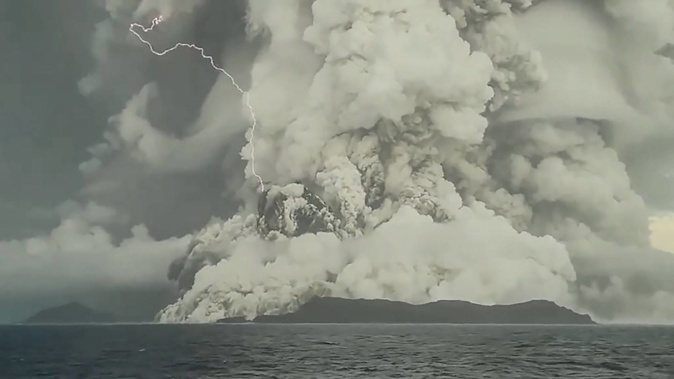
The Tongan volcanic eruption that sent shock waves and a tsunami across the world was so powerful, it caused a large chunk of the earth’s seafloor to disappear.
It is also officially the largest eruption ever recorded on the planet, scientists confirmed.
Hunga-Tonga Hunga-Ha’apai sent people on the island nation running for their lives when the powerful eruption happened earlier this year, on January 15.
Scientists from the National Institute for Water and Atmospheric Research have just finished a full investigation into the incident and concluded that emitted the biggest atmospheric explosion recorded on Earth in more than a century.
Niwa said almost 10 cubic km of seafloor was displaced during the eruption - the equivalent of 2.6 million Olympic-sized swimming pools - and that 75 per cent of that material was deposited within 20km of the volcano.
“This leaves almost 3.2 cubic km unaccounted for,” Niwa said.
Marine geologist Kevin Mackay said the missing material could be partly explained to aerial loss.
“This is why we didn’t notice the loss until we had mapped everything. The eruption reached record heights - being the first we’ve ever seen to break through into the mesosphere.”
/cloudfront-ap-southeast-2.images.arcpublishing.com/nzme/52XFN5GBNTE72CZCIP4KAHLN6I.jpg)
Tonga's Hunga Tonga Hunga Ha'apai volcano erupted on January 15 causing substantial damage and was followed by a tsunami. Photo / NZDF
- First images of devastating damage as Tongan residents warned air toxic, water contaminated
- Tongan Olympian hasn't heard from family since volcanic eruption, tsunami
- 'Our beautiful girl is missing': Fears for missing aid worker after Tonga tsunami
The mesosphere - known as the coldest place on Earth - is the highest layer of the atmosphere and is the space between the thermosphere and the stratosphere.
“It was like a shotgun blast directly into the sky,” Mackay said.
“The volume of this shotgun plume is estimated to be 1.9 cubic km of material which has been circulating in our atmosphere for months - causing the stunning sunsets we saw following the eruption.”
Scientists found that despite the huge displacement of material, the volcano’s flank was still intact - something that was said to be surprising.
It was also discovered that the volcano’s crater was now 700m deeper than what it was before the eruption.
Impact on Tonga
Three deaths were reported after the eruption and subsequent tsunami that hit the small island nation - somewhat remarkable, given the enormity of the incident.
The country’s communication underwater communication lines were severed in the eruption; effectively cutting the country off from the rest of the world.
Internet connection was restored just over five weeks later.
Much of the Tonga was left covered in a blanket of thick black volcanic ash and up to 85 per cent of the country was affected by the event, which the Tongan Government described as an “unprecedented disaster” at the time.
/cloudfront-ap-southeast-2.images.arcpublishing.com/nzme/FNK3W4VGAMGJC735VY7TRPVGPU.jpg)
Ash from the eruption of the undersea Hunga Tonga Hunga Ha'apai volcano in the capital Nuku'alofa, the capital of Tonga. Photo / Kofeola Marian Kupu, File
Take your Radio, Podcasts and Music with you









